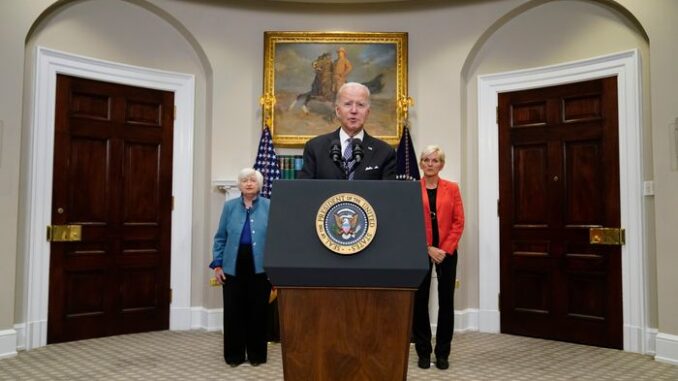
Elevated fuel prices and shortages remain a concern for U.S. consumers ahead of Tuesday’s midterm elections, in which energy costs have become a crucial campaign issue.
After a steady decline this fall, the average price of unleaded regular gasoline has been ticking up again, reaching $3.80 a gallon on Sunday, according to AAA, a far cry from the $5 gasoline that stung drivers in June, but still 38 cents higher compared with the same period last year. It is also $1.40 higher than when President Biden took office.
The average price of diesel, meanwhile, hasn’t slipped under $5 a gallon for close to a month, and stockpiles of the fuel counted weekly haven’t been this low since 2005, according to AAA and federal data.
More than half of Americans participating in a Quinnipiac University national poll released Wednesday said the price of gas and consumer goods was the economic issue they are most worried about right now, compared with 25% who cited the cost of housing and rent.
Mr. Biden has made alleviating fuel pains a regular talking point, tweeting precise updates on declining gas prices and urging oil-and-gas companies to produce more fuel. On Friday, he said on Twitter that gas prices had declined by 24% over the past 20 weeks.
The administration has tried to tamp down energy prices by ordering the largest release ever from the federal oil reserves, which according to industry experts has had a limited effect on prices. The administration also has called, unsuccessfully, on U.S. oil producers to invest more of the industry’s recent record profits in expanding production instead of increasing shareholder payouts.
The energy sticker shock this year has played a significant part in inflation seeping into the daily expenses of Americans. The forces that have pulled fuel prices higher include recovering demand after the height of the Covid-19 pandemic, a shuffling of oil and petroleum flows after Russia’s invasion of Ukraine, and shutdowns of refineries, all taking place against a backdrop of reduced investments in the oil-and-gas industry, analysts said.
“We never got back to pre-Covid in terms of…the balance between supply and demand for oil and gasoline and diesel,” said Patrick De Haan, head of petroleum analysis at price tracker GasBuddy.
Gas prices in recent weeks have stabilized, in part because of refineries ending seasonal maintenance that had taken some fuel-making capacity off the market, analysts said. Still, inventories of gasoline for the week ended Oct. 28 remained 7.6% lower than they were a year earlier, according to the Energy Information Administration, a deficit that has shrunk during the past few months.
The winter season should bring some relief, analysts said, because it traditionally generates lower demand for gas as fewer drivers get on the road, a development that is expected to keep prices relatively low. Refiners increasing the share of inexpensive butane in gasoline to produce winter-grade fuel are also likely to soften prices, analysts said.

Diesel’s average price hasn’t fallen below $5 a gallon for close to a month.PHOTO: AIMEE DILGER/REUTERS
Stocks of diesel and heating oil, on the other hand, haven’t been this low at this time of year since October 1951, according to Andy Lipow, president of consulting company Lipow Oil Associates LLC, citing EIA data. Tight stocks have translated into prices sticking well above $5 a gallon this year, compared with an average of about $3.14 in 2021, according to AAA data. The national average price of a gallon of diesel was $5.33 on Sunday, according to AAA.
Stock depletions have been especially pronounced in the Northeast, which relies in part on diesel and heating oil for warming homes. Markets in the Southeastern U.S. also are beginning to feel an impact. Mansfield Energy Corp., a Georgia-based fuel supplier, warned customers of potential shortages last week.
One reason for the dearth of diesel is that global markets are craving the fuel, in part because of the loss of about 400,000 barrels of diesel a day that previously flowed from Russia to Europe, and new international emissions requirements resulting in ships using more diesel, said John Auers, an analyst at consulting firm RBN Energy.
Meanwhile, fuel-making capacity in Europe and the U.S. has decreased by about 3 million barrels a day since before the pandemic, according to consulting firm Rystad Energy, limiting how much diesel refiners can churn out to meet that growing need.

Refinery maintenance had taken some fuel-making capacity off the market.PHOTO: MARK FELIX/BLOOMBERG NEWS
Another factor pulling down U.S. inventories is refiners ramping up exports of the fuel, said Roger Read, a senior energy analyst at Wells Fargo & Co. The percentage of diesel exported by the U.S. has increased to 30% of production from 25% in recent years, he said.
In a September meeting with oil executives, Biden administration officials said that if companies didn’t fill up domestic stockpiles, the government could limit fuel exports. Industry executives have said that such a move would crimp global supplies and lift domestic prices.
High diesel prices provide an incentive for suppliers to sell their product now rather than hold on to it and sell it later for an inferior profit, according to Mr. Lipow, further shrinking inventories. “It simply makes no economic sense to increase inventory in today’s high price environment,” he wrote in a note last week.
Cold weather, which could drive demand for heating oil in the Northeast, and a European Union-led import ban on Russian refined-petroleum products starting on Feb. 5 could further stress global diesel markets, Mr. Auers said.



